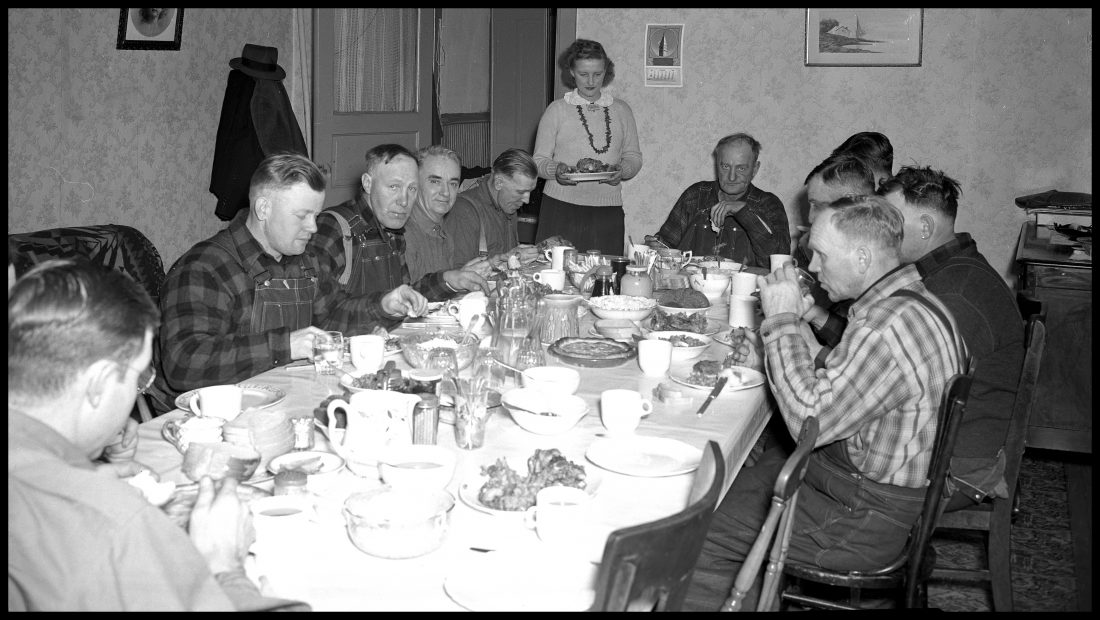The ghosts of U.P. boarding houses

Delta County Historical Society Archives photo The supper table at the St. Paul boarding house.

Delta County Historical Society Archives photo
Dock workers hang up their hats and coats at the St. Paul boarding house in 1943.
ESCANABA — Before the days of Best Westerns and Holiday Inns, the U.P. had its boarding houses.
Maybe your grandparents or great-grandparents spent some time living at a boarding house when they immigrated to Michigan.
The boarding houses of the olden days sprung up alongside thriving businesses. They were usually built quickly and cheaply.
Lumber companies, mines, and railroads drew in young, ambitious workers from all over to Upper Michigan. A new job in a new place had men scurrying to find a roof over their heads.
A gray, wooden ghost still stands in Delta County. It is the Fayette boarding house in the chilly big Bay de Noc air. People can visit this relic from the iron smelting days of long ago.
Close to the Escanaba River, the I Stephenson Lumber Company provided a boarding house in Wells, Michigan. Many of us had relatives that worked there or ate there.
North Escanaba was once the home of several ore docks. The St. Paul ore dock was constructed alongside others in the harbor around the turn of the century.
The men who worked on the dock needed a place to stay so the St. Paul boarding house was slapped together quickly with roughhewn lumber. Limestone slabs from the local quarry made up the foundation.
This big house on the 1400 block of Sheridan Road (Hartnet Avenue) had two floors and a large attic. Back in the day, it took in thirty-five dock workers.
From an article in a 1943 Escanaba Daily Press, we learn that a typical meal at the boarding house consisted of 25 pounds of meat, 8 quarts of beans, and three pecks of potatoes, plus pies for dessert.
The attic window in the St. Paul boarding house faced east spying out upon the bay and the incoming ore boats.
When the men were done with their day high up on the sturdy wooden docks, to the boarding house they’d walk. Each boarded had their assigned hook for their coat and hat. Each boarder took their place at the long table.
In the 1940s, after the St. Paul docks were no longer in use, the boarding house was purchased by my grandfather, John Stasewich. With a wife and nine children, John worked to transform the boarding house into a family home.
My grandparents passed away tragically in 1945, leaving my mother to raise her younger siblings and later her own children at the St. Paul boarding house.
To a small child, the old boarding house seemed like a mansion. We had more rooms, stairs, doorways and windows than any other kids.
My dad was a wonderful carpenter and maintenance man. Dad could build or repair almost anything. His handcrafted furniture, kitchen cupboards, book cases and home repairs made the old house comfortable. My brother recalls that one of the best things he did was to put a “tiny” bathroom on the first floor.
My family lived at the boarding house until I was about seven, and then we moved a few blocks away.
The old St. Paul boarding house taught us how to love the history of the awesome U.P. And we always wondered why our bedroom doors had little numbers on them.
What boarding houses did your folks stay at?
——
Karen (Rose) Wils is a lifelong north Escanaba resident. Her folksy columns appear weekly in Lifestyles.


